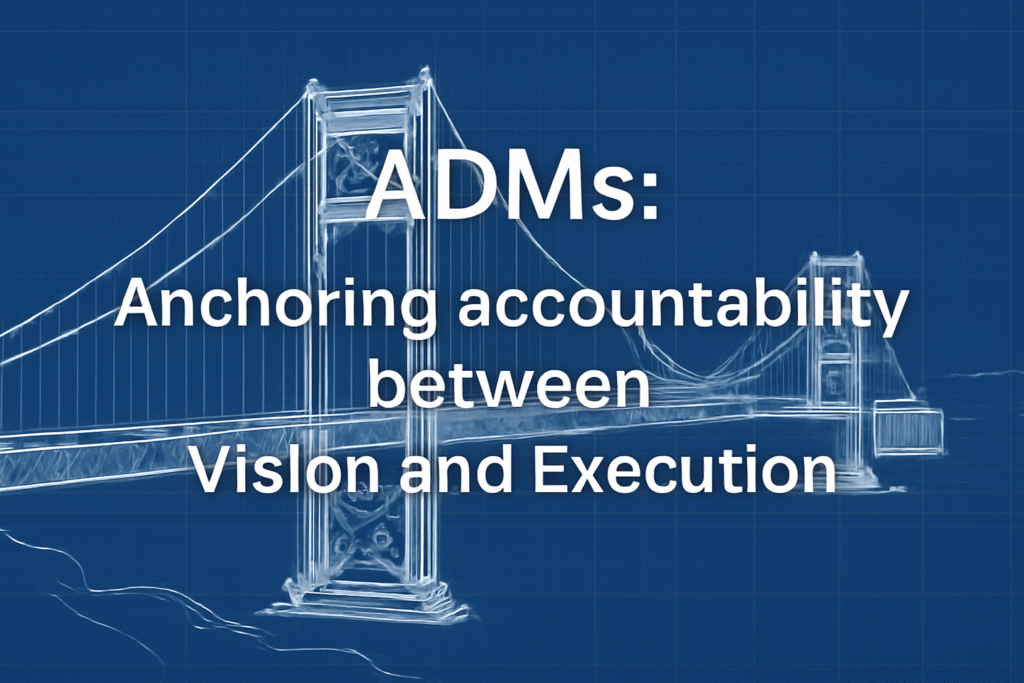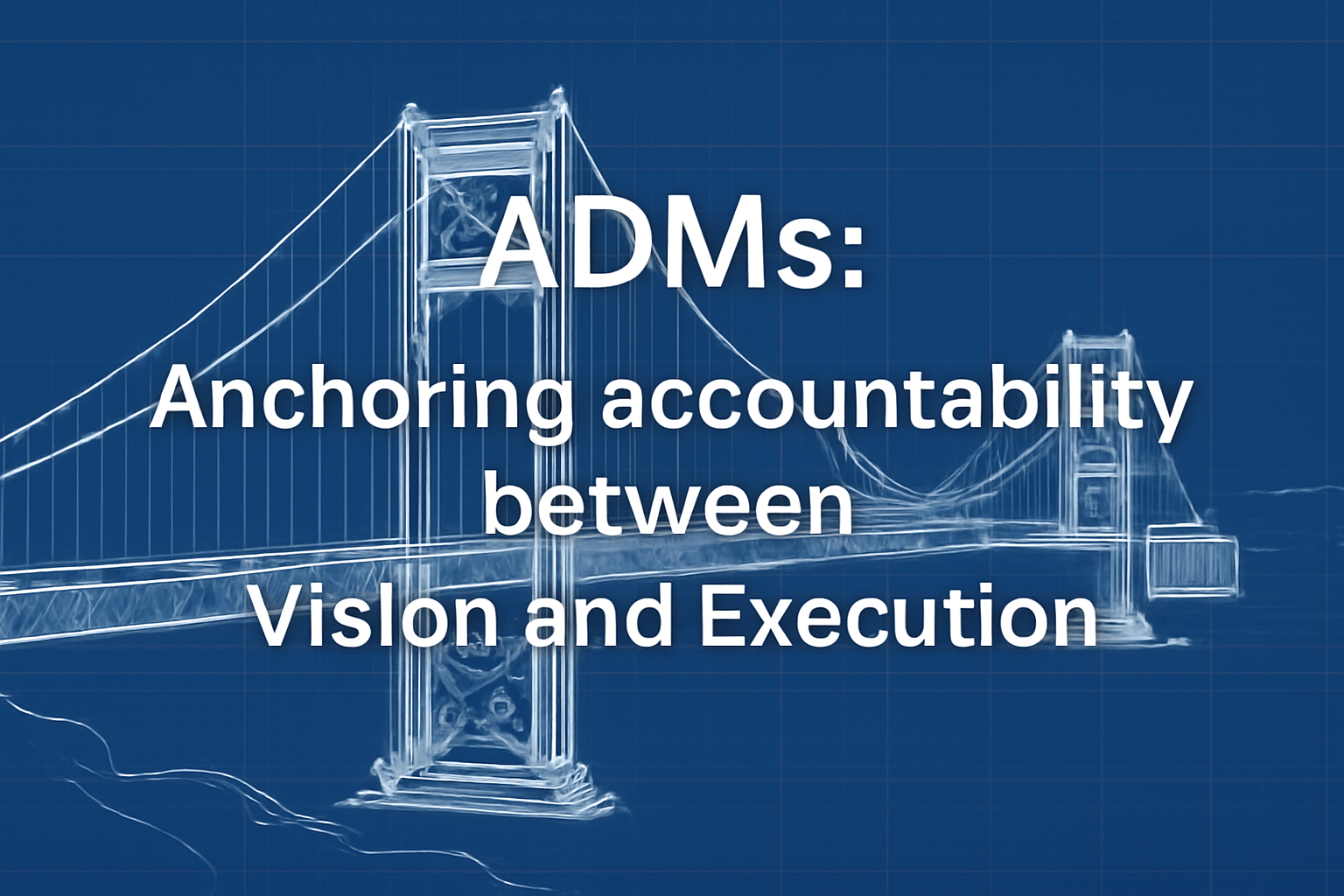ADMs at the Accountability Crossroads
Assistant Deputy Ministers (ADMs) occupy one of the most complex roles in the Canadian federal government. Positioned between the strategic leadership of Deputies and the operational oversight of Directors General (DGs), ADMs are simultaneously accountable for translating political priorities into actionable strategies and ensuring their execution across complex bureaucracies.

In transformation initiatives, this “middle-anchor” role becomes pivotal. ADMs must balance competing pressures: managing up to Ministers and Deputies, coordinating across horizontal functions, and maintaining credibility with DGs and frontline executives. When accountability falters at the ADM level, transformation risks stalling. But when ADMs embrace and model accountability, they create the conditions for success throughout the department.
Why ADMs Matter for Transformation
Research on public service leadership shows that middle executives, such as ADMs, are critical “sense-makers” who ensure that political intent and bureaucratic action align (Bourgault & Savoie, 2006; Aucoin, 2012).
ADMs play three core roles in transformation:
- Interpreters of Ministerial Direction – translating broad policy goals into practical strategies.
- Coordinators of Complexity – integrating efforts across multiple DG-led branches and functions.
- Accountability Anchors – holding themselves and their teams responsible for progress, while ensuring Deputies have confidence in execution.
Without ADM accountability, Deputies lack the assurance needed to delegate boldly, and DGs lack the clarity to act decisively.
Accountability as an ADM’s Leadership Imperative
Accountability is often described as the ADM’s “currency of trust.” It is how Deputies measure reliability and how DGs determine whether they can confidently move forward.
Strong ADM accountability includes:
- Owning the translation space – ensuring that political direction is clear and actionable.
- Modeling responsibility – not passing blame downward to DGs or upward to Deputies.
- Tracking and reporting progress – creating transparent systems that build credibility.
As one senior ADM reflected in an Institute for Public Administration of Canada (IPAC) panel:
“You don’t build Deputy confidence by reporting excuses—you build it by reporting progress, even when the news isn’t good.”
The “Squeeze Zone” Challenge
ADMs often describe themselves as operating in a “squeeze zone,” caught between political imperatives and operational realities. Scholars of Canadian public administration note that ADMs must constantly manage expectations while preserving organizational morale (Savoie, 2019; Lindquist, 2017).
This squeeze creates accountability stress:
- Deputies expect transformation to move quickly.
- DGs expect resources, clarity, and protection from political volatility.
- Horizontal partners demand alignment, even when mandates diverge.
When accountability is unclear in this zone, transformation slows, as DGs hesitate to act and Deputies micromanage to fill perceived gaps.
Strategies for Effective ADM Accountability
ADMs who succeed in anchoring accountability adopt deliberate strategies:
- Clarify Priorities Relentlessly
Political direction often arrives in broad strokes. ADMs must translate this into specific, prioritized actions. Research shows that leaders who provide clarity accelerate change by reducing uncertainty for subordinates (Kotter, 2012). - Establish Transparent Performance Mechanisms
Regular dashboards, progress reviews, and early escalation of challenges build Deputy confidence. Transparency fosters trust, which in turn reduces micromanagement (OECD, 2020). - Model Cultural Accountability
By owning outcomes—good and bad—ADMs set the tone for DGs. Thus cultural signaling reduces risk aversion and builds a shared commitment to results. - Balance Pressure with Support
Holding DGs accountable without offering resources or guidance creates resistance. Effective ADMs combine accountability with coaching, enabling DGs to succeed.
Case Example: ADM Leadership in Regulatory Transformation
During a government-wide regulatory modernization initiative, one ADM faced significant resistance from DGs concerned about resource pressures. Rather than passing the problem upward, the ADM owned accountability by developing a prioritization framework, bringing clarity to what could realistically be delivered.
The ADM transparently reported these constraints to the Deputy, framing them as informed trade-offs rather than failures. This built trust with the Deputy, empowered DGs to focus their efforts, and ultimately delivered visible progress.
The lesson: accountability isn’t about perfection—it’s about clarity, ownership, and follow-through.
The Cultural Role of ADMs
Beyond operational coordination, ADMs shape culture. Deputies look to ADMs to model the leadership behaviours they want DGs to emulate. When ADMs own accountability, demonstrate resilience under pressure, and communicate transparently, these traits cascade downward.
Conversely, when ADMs deflect blame, overmanage, or avoid hard decisions, accountability erodes. DGs retreat into risk aversion, Deputies lose confidence, and transformation falters.
Leadership research emphasizes the multiplier effect of “middle-tier” executives: their cultural signals ripple both upward and downward (Denhardt & Denhardt, 2015). ADMs are therefore not just administrators—they are cultural architects.
Independent Insight for ADMs
Independent advisory support can strengthen ADM accountability by:
- Providing tools for strategic alignment – ensuring priorities remain coherent amidst shifting political signals.
- Helping manage the “squeeze zone” – offering frameworks for balancing Deputy expectations and DG realities.
- Enhancing leadership presence – coaching ADMs on how to model accountability and build trust.
Such support enables ADMs to transform their squeeze zone into a leverage point for organizational success.
Conclusion: ADMs as Anchors of Transformation
ADMs hold one of the toughest but most influential roles in government transformation. By owning accountability, clarifying priorities, and balancing competing pressures, they anchor both Deputy confidence and DG execution.
Transformation succeeds not because Deputies or DGs act alone, but because ADMs translate vision into action, and action into results. In short: ADMs who embrace accountability become the indispensable anchors of transformation.
What’s Next?
Institute X works with ADMs to strengthen leadership presence, manage the “squeeze zone,” and build accountability systems that accelerate transformation across government.
References
- Aucoin, P. (2012). New Political Governance in Westminster Systems. Public Policy Forum.
- Bourgault, J., & Savoie, D. J. (2006). “Breaking Down the Barriers to Whole-of-Government Performance.” Canadian Public Administration, 49(1), 1–23.
- Denhardt, J. V., & Denhardt, R. B. (2015). The New Public Service: Serving, Not Steering. Routledge.
- Kotter, J. (2012). Leading Change. Harvard Business Review Press.
- Lindquist, E. (2017). “Reconciling Tensions at the Political–Administrative Interface: Perspectives on Deputies and ADMs.” Canadian Public Administration, 60(3), 359–379.
- OECD (2020). Leadership for a High-Performing Civil Service. OECD Publishing.
- Savoie, D. J. (2019). Democracy in Canada: The Disintegration of Our Institutions. McGill-Queen’s University Press.

